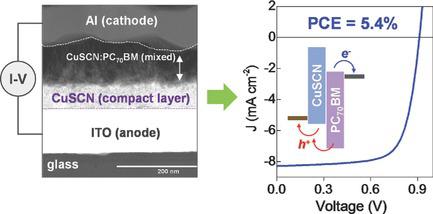Our official English website, www.x-mol.net, welcomes your feedback! (Note: you will need to create a separate account there.)
High‐Efficiency Fullerene Solar Cells Enabled by a Spontaneously Formed Mesostructured CuSCN‐Nanowire Heterointerface
Advanced Science ( IF 15.1 ) Pub Date : 2018-02-02 , DOI: 10.1002/advs.201700980 Wai-Yu Sit 1 , Flurin D Eisner 1 , Yen-Hung Lin 1 , Yuliar Firdaus 2 , Akmaral Seitkhan 2 , Ahmed H Balawi 2 , Frédéric Laquai 2 , Claire H Burgess 3 , Martyn A McLachlan 3 , George Volonakis 4 , Feliciano Giustino 4, 5 , Thomas D Anthopoulos 1, 2
Advanced Science ( IF 15.1 ) Pub Date : 2018-02-02 , DOI: 10.1002/advs.201700980 Wai-Yu Sit 1 , Flurin D Eisner 1 , Yen-Hung Lin 1 , Yuliar Firdaus 2 , Akmaral Seitkhan 2 , Ahmed H Balawi 2 , Frédéric Laquai 2 , Claire H Burgess 3 , Martyn A McLachlan 3 , George Volonakis 4 , Feliciano Giustino 4, 5 , Thomas D Anthopoulos 1, 2
Affiliation

|
Fullerenes and their derivatives are widely used as electron acceptors in bulk‐heterojunction organic solar cells as they combine high electron mobility with good solubility and miscibility with relevant semiconducting polymers. However, studies on the use of fullerenes as the sole photogeneration and charge‐carrier material are scarce. Here, a new type of solution‐processed small‐molecule solar cell based on the two most commonly used methanofullerenes, namely [6,6]‐phenyl‐C61‐butyric acid methyl ester (PC60BM) and [6,6]‐phenyl‐C71‐butyric acid methyl ester (PC70BM), as the light absorbing materials, is reported. First, it is shown that both fullerene derivatives exhibit excellent ambipolar charge transport with balanced hole and electron mobilities. When the two derivatives are spin‐coated over the wide bandgap p‐type semiconductor copper (I) thiocyanate (CuSCN), cells with power conversion efficiency (PCE) of ≈1%, are obtained. Blending the CuSCN with PC70BM is shown to increase the performance further yielding cells with an open‐circuit voltage of ≈0.93 V and a PCE of 5.4%. Microstructural analysis reveals that the key to this success is the spontaneous formation of a unique mesostructured p–n‐like heterointerface between CuSCN and PC70BM. The findings pave the way to an exciting new class of single photoactive material based solar cells.
中文翻译:

由自发形成的介观结构CuSCN-纳米线异质界面实现的高效富勒烯太阳能电池
富勒烯及其衍生物广泛用作本体异质结有机太阳能电池中的电子受体,因为它们结合了高电子迁移率以及与相关半导体聚合物良好的溶解度和混溶性。然而,关于使用富勒烯作为唯一的光生材料和载流子材料的研究很少。这里,一种基于两种最常用的亚甲基富勒烯的新型溶液处理小分子太阳能电池,即[6,6]-苯基-C61-丁酸甲酯(PC 60 BM)和[6,6 ] -据报道,苯基-C71-丁酸甲酯(PC 70 BM)作为光吸收材料。首先,结果表明,两种富勒烯衍生物均表现出优异的双极性电荷传输以及平衡的空穴和电子迁移率。当这两种衍生物旋涂在宽带隙 p 型半导体硫氰酸铜 (I) (CuSCN) 上时,获得了功率转换效率 (PCE) 约 1% 的电池。将 CuSCN 与 PC 70 BM 混合可进一步提高性能,使电池的开路电压约为 0.93 V,PCE 为 5.4%。微观结构分析表明,这一成功的关键是在 CuSCN 和 PC 70 BM之间自发形成独特的介观结构 p-n 类异质界面。这些发现为基于单一光活性材料的新型令人兴奋的太阳能电池铺平了道路。
更新日期:2018-02-02
中文翻译:

由自发形成的介观结构CuSCN-纳米线异质界面实现的高效富勒烯太阳能电池
富勒烯及其衍生物广泛用作本体异质结有机太阳能电池中的电子受体,因为它们结合了高电子迁移率以及与相关半导体聚合物良好的溶解度和混溶性。然而,关于使用富勒烯作为唯一的光生材料和载流子材料的研究很少。这里,一种基于两种最常用的亚甲基富勒烯的新型溶液处理小分子太阳能电池,即[6,6]-苯基-C61-丁酸甲酯(PC 60 BM)和[6,6 ] -据报道,苯基-C71-丁酸甲酯(PC 70 BM)作为光吸收材料。首先,结果表明,两种富勒烯衍生物均表现出优异的双极性电荷传输以及平衡的空穴和电子迁移率。当这两种衍生物旋涂在宽带隙 p 型半导体硫氰酸铜 (I) (CuSCN) 上时,获得了功率转换效率 (PCE) 约 1% 的电池。将 CuSCN 与 PC 70 BM 混合可进一步提高性能,使电池的开路电压约为 0.93 V,PCE 为 5.4%。微观结构分析表明,这一成功的关键是在 CuSCN 和 PC 70 BM之间自发形成独特的介观结构 p-n 类异质界面。这些发现为基于单一光活性材料的新型令人兴奋的太阳能电池铺平了道路。



























 京公网安备 11010802027423号
京公网安备 11010802027423号